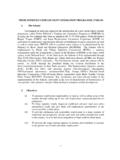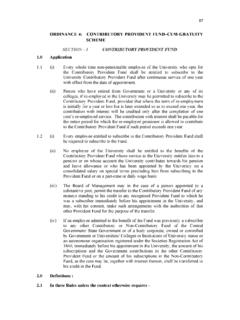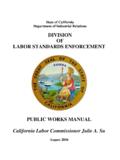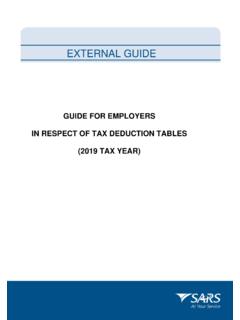Transcription of Swarna Jayanti Shahari Rozgar Yojana (SJSRY) …
1 Swarna Jayanti Shahari Rozgar Yojana (SJSRY). GUIDELINES. INTRODUCTION: The Swarna Jayanti Shahari Rozgar Yojana (SJSRY) shall seek to provide gainful employment to the urban unemployed or underemployed poor through encouraging the setting up of self employment ventures or provision of wage employment. This programme will rely on creation of suitable community structures on the UBSP pattern and delivery of inputs under this programme shall be through the medium of urban local bodies and such community structures. The Swarna Jayanti Shahari Rozgar Yojana shall be funded on a 75:25 basis between the Centre and the States.
2 The Swarna Jayanti Shahari Rozgar Yojana shall consist of two special schemes, namely:- (i) The Urban Self Employment Programme (USEP). (ii) The Urban Wage Employment Programme (UWEP). SALIENT FEATURES: The Swarna Jayanti Shahari Rozgar Yojana shall rest on a foundation of community empowerment. Rather then relying on the traditional method of top down implementation, this programme shall rely on establishing and promoting community organisations and structures to provide supporting and facilitating mechanism for local development.
3 Towards this end community organisations like Neighbourhood Groups (NHGs), Neighbourhood Committees (NHCs), and Community Development Societies (CDSs) shall be set up in the target areas based on the UBSP pattern (Annexure IV). The CDSs shall be the focal point for the purposes of identification of beneficiaries, preparation of applications, monitoring of recovery, and generally providing whatever other support is necessary to the programme. The CDSs will also identify viable project suitable for that particular area.
4 These CDSs may also set themselves up as Thrift and Credit societies to encourage community savings, as also other group activities. However, Thrift and Credit Societies may be set up separate from the CDSs as well. These bodies will try to link local resource generation efforts with wider institutional finance. It is expected that these bodies will be registered under the Societies Registration Act or other appropriate Acts to provide them direct access to funds under various schemes as also a wider finance and credit base.
5 A maximum expenditure at the rate of Rs. 100 per member for the first year, and Rs. 75 per member for each subsequent year will be allowed for activities connected with the CDSs. The CDSs, being a federation of different community based organisations, shall be the nodal agency for this programme. It is expected that they will lay emphasis on providing the entire gamut of social sector inputs to their areas including, but not limited to, health, welfare, education, etc. through establishing convergence between schemes being implemented by different line departments within their jurisdiction.
6 THE URBAN SELF EMPLOYMENT PROGRAMME (USEP): This programme will have three distinct parts: - (i) Assistance to individual urban poor beneficiaries for setting up gainful self employment ventures. (ii) Assistance to groups of urban poor women for setting up gainful selfemployment ventures. This sub- scheme maybe called" The Scheme for Development of Women and Children in the Urban Areas (DWCUA)". (iii) Training of beneficiaries, potential beneficiaries and other person associated with the urban employment programme for upgradation and acquisition of vocational and entrepreneurial skills.
7 COVERAGE. (i) The programme will be applicable to all urban towns in India. (ii) The programme will be implemented on the whole town basis with special emphasis on urban poor clusters. TARGET GROUPS. (i) The programme shall target the urban poor, defined as those leaving below the urban poverty line, as defined from time to time. (ii) Special attention will be given to women, persons belonging to Scheduled Castes/ Tribes, disabled person and other such categories as maybe indicated by the Government from time to time.
8 The percentage of women beneficiaries under this programme shall not be less than 30%. SCs and STs must be benefited at least to the extent of the proportion of their strength in the local population. A special provision of 3% shall be reserved for the disabled under this programme. (iii) Educational Qualification: There will be no minimum educational qualification for beneficiaries under this programme. However, to avoid an overlap with the PMRY scheme, for the self-employment component, this scheme shall not apply to beneficiaries educated beyond the IX standard.
9 As regards the wage employment component, there will be no restrictions of educational qualifications whatsoever. Where the identified activity requires skill, training of an appropriate level, as may be necessary, will be provided to the beneficiaries before extending financial support. (iv) A house-to-house survey for identification of genuine beneficiaries will be done. Non- economic parameters will also be applied to identify the urban poor in addition to the economic criteria of the urban poverty line. (Detailed Guidelines are given in Annexure I).
10 Community structure like the CDSs will be involved in this task under the guidance of the Town Urban Poverty Eradication Cell/ Urban Local Body. Lists of beneficiaries finalised will be displayed at the Urban Local Body Office as also in the concerned local areas. For ease of operation, if desired, the house-to-house survey and beneficiary identification can be got done by the State nodal agency through any identified body at the ULB/community level specially empowered in this behalf. All other conditions being equal, women beneficiaries belonging to womenheaded households shall be ranked higher in priority than other beneficiaries.






